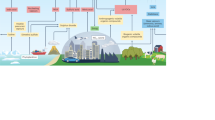Abstract
During May-June of 1990 an extensive flight series to survey aerosol present in the upper-troposphere was undertaken aboard the NASA DC-8 as part of the CLObal Backscatter Experiment (GLOBE). About 50,000 km were characterized between 8–12 km altitude and between 70°N and 58°S. Aerosol with diameters greater than 3nm were counted and sized with a combination of condensation nuclei counters and optical particle counters. Aerosol number and mass concentrations were separately identified with regard to both refractory and volatile components. Regions of the free-troposphere with the lowest mass concentrations were generally found to have the highest number concentrations and appeared to be effective regions for new particle production. These new particle concentrations appear inversely related to available aerosol surface area and their volatility suggests a sulfuric acid composition. The long lifetime of these new particles aloft can result in their growth to sizes effective as CN and CCN that can be mixed throughout the troposphere.
Similar content being viewed by others
References
Ramanathan V., Cess R.D., Harrison E.F., Minnis P., Barkstrom B.R., Ahmad E. and Hartmann D. (1989) “Cloud radiative forcing and climate: Results from the earth radiation budget experiment”, Science 243, 57–63.
Charlson R.J., Lovelock J.E., Andreae M.O. and Warren S.G. (1987) “Oceanic phytoplankton, atmospheric sulfur, cloud albedo and climate: A geophysical feedback”, Nature 326, 655–661.
Albrecht B.A. (1989) “Aerosols, cloud microphysics and fractional cloudiness”, Science 245, 1227–1230.
Latham J. and Smith M.H. (1990) “Effects on global warming of wind-dependent aerosol generation at the ocean surface”, Nature 347, 372–373.
Schwartz S.E. (1988) “Are global cloud albedo and climate controlled by marine phytoplankton”, Nature 336, 441–445.
Twomey S. (1977) Atmospheric Aerosols, Elsevier, Amsterdam.
Baker M.B. and Charlson R.J. (1990) “Bistability of CCN concentrations and thermodynamics in the cloud topped boundary layer”, Nature 345, 142–145.
Bates T.S., Clarke A.D., Kapustin V.K., Johnson J.E. and Charlson R.J. (1989) “Oceanic dimethysulfide and marine aerosol: Difficulties associated with assessing their covarience”, Global Biogeochem. Cyc. 3, 299–304.
Helas, G., Andreae, M.O. and Hudson, J.G. (1990) EOS abstract A11A-8, 1225.
Hegg D.A., Radke L.F. and Hobbs P.V. (1990) “Particle production associated with marine clouds”, J. Geophys. Res. 95, 13917–13926.
Clarke A.D., Ahlquist N.C. and Covert D.S. (1987) “The Pacific marine aerosol: Evidence for acid sulfates”, J. Geophys. Res. 92, 4179–4190.
Savoie D.L. and Prospero J.M. (1982) “Particle size distribution of nitrate and sulfate in the marine atmosphere”, Geophys. Res. Lett. 9, 1207–1210.
Andreae M.O., Berresheim H., Andreae T.W., Kritz M.A., and Bates T.S. (1988) “Vertical distribution of dimethylsulfide, sulfur dioxide formic acid, aerosol ions and radon over the northeast Pacific Ocean”, J. Atmos. Chem. 6, 149–173.
Porter, J.N. and Clarke, A.D. (in press) “Aircraft studies of size dependent aerosol sampling”, Jour. Geophys. Res.
Clarke A.D. (1991) “A thermooptic technique for in-situ analysis of size-resolved aerosol physicochemistry”, Atmos. Env. 25A, 635–644.
Prospero J.M. (1989) The Large Scale Atmospheric Transport of Natural and Contaminant Substances, Reidel, Dordrect, Holland.
McMurry P.H. and Friedlander S.K. (1978) “Aerosol formation in reacting gases: Relation of surface area to rate of gas to particle conversion”, J. Colloid and Interface Science 64, 248–257.
Pruppacher H.R. and Klett J.D. (1978) Microphysics of Clouds and Precipitation 226, Reidel, Dordrecht.
Shaw G.E. (1989) “Production of condensation nuclei in clean air by nucleation of H2SO4”, Atmos. Env. 23, 2841–2846.
Flyger H., Heidam N.Z., Hansen K., Megaw W.J., Walther E.G. and Hogan A.W. (1976) “The background level of summer tropospheric aerosol over Greenland and the North Atlantic”, J. Aerosol Sci. 7, 103–140.
Hopple W.A., Dinger J.E., and R.E. Ruskin (1973) “Vertical profiles of CCN at various geographical locations”, J. of Atmos. Sci. 30, 1410–1419.
Dinger J.E., Howell H.B. and Wojciechowski, (1970) “On the source and composition of cloud condensation nuclei in the subsident air masses over the North Atlantic”, J. Atmos. Sci. 27, 791–797.
Bigg E.K., Gras J.L., and Evans C. (1984) “Origin of aitken particles in remote regions of the southern hemisphere”, J. Atmos. Chem. 1, 203–214.
Saltzman E.S., Savoie D.L., Prospero J.M., and R.G. Zika (1986) “Methanesulfonic acid and non-sea-salt sulfate in Pacific air: Regional and seasonal variations”, J. Atmos. Chem. 4, 227–240.
Parungo F.P., Nagamoto C.T., Rosinski J., and Haagenson P.L. (1986) “A study of marine aerosols over the Pacific Ocean”, J. Atmos. Chem. 4, 199–226.
Andreae M.O. (1983) “Soot carbon and excess fine potassium: Long range transport of combustion derived aerosols”, Science 2, 744–747.
Aitken, J. Proc. Royal Soc. Edinburg 32, 183, 1910–11.
Bigg E.K. and Turvey D.E. (1978) “Sources of atmospheric particles over Australia”, Atmos. Env. 12, 1643–1655.
Kreidenwies S.M. and Sienfeld J.H. (1988) “Nucleation of sulfuric acid-water and methanesulfonic acid-water particles: Implications for the atmospheric chemistry of organosulfur species”, Atmos. Env. 22, 283–296.
Voiriol A.J. and Mirabel P. (1989) “Heteromolecular nucleation in the sulfuric acid-water system”, Atmos. Env. 23, 2053–2057.
Hidy G.M., Katz J.L. and Mirabel P. (1978) “Sulfate aerosol formation and growth in the stratosphere”, Atmos. Env. 12, 887–892.
Hopple W.A. and Frick G.M. (1990) “Submicron aerosol size distributions measured over the tropical and south Pacific”, Atmos. Env. 24A, 645–659.
Gage, K.S. (1991) personnal communication.
Clarke A.D. (1989) “Aerosol light absorption by soot in remote environments”, Aerosol Sci. and Tech. 10, 161–171.
Clarke A.D. and Charlson R.J. (1985) “Radiative properties of the background aerosol: Absorption component of extinction”, Science 229, 263–265.
Author information
Authors and Affiliations
Rights and permissions
About this article
Cite this article
Clarke, A.D. Atmospheric nuclei in the remote free-troposphere. J Atmos Chem 14, 479–488 (1992). https://doi.org/10.1007/BF00115252
Published:
Issue Date:
DOI: https://doi.org/10.1007/BF00115252




